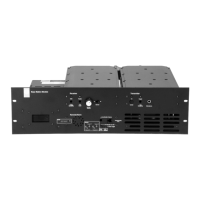D2.4 Circuit Operation M8SL2-00-002-812
© Copyright Tait Electronics Limited August 2004. All rights reserved.
• mute audio from Line-In and receiver;
• delay the audio.
The microcontroller boot loads the DSP, interfaces with the user via the front panel
switches and LEDs, interfaces with PGM800Win and runs the T803 state machines
(alarm monitoring, alarm tone generation, high level guard tone/function tone/low
level guard tone timing, RSSI/voting tone conversion etc.).
2.2 Tone Detection
In the quiescent state, audio on the Line-In pair is passed through the DSP (IC300) unfil-
tered to the T803 loudspeaker (which is connected to Tx audio – TP203). The audio is
bandpass filtered to detect guard tone. In normal operation (keytone and function tone
operation) the tone detector threshold is set for high level guard tone (HLGT).
If HLGT is detected, the DSP signals this detection to the micro using the
TONE_DETECT line (TP300 is pulled low). The micro instructs the DSP, using the asyn-
chronous serial communications connection (TP306) between them, to switch on the in
line guard tone notch filter, lower the threshold of the guard tone detector (so that it can
detect low level guard tone – LLGT) and turn on the function tone detectors.
Where the T803 is operating in 2-wire mode and receiver audio (RX audio) is being
gated to line, the micro will soft mute the RX audio first). The micro then starts an inter-
nal timer, the duration of which is set by the HLGT and function tone times pro-
grammed by PGM800Win.
If a function tone is detected, the DSP signals the micro using the CALL_UP line (TP301
pulled low). The micro then interrogates the DSP via the serial communications connec-
tion to find out what frequency was detected.
If no tones are detected and the timer expires, the micro resets the DSP to its quiescent
state. If two different frequencies are detected or if only one function tone frequency is
decoded and the timer expires, the micro decodes them/it into an action by reading
data programmed into the EEPROM (IC312) by PGM800Win. The micro then keys on
the transmitter (PTT line) and instructs the DSP to turn off the function tone detectors
and the talk-through gate (if it was on). If the function tone sequence decodes into a
channel number that is different from the currently set channel, the micro will output
the channel number on CH0 – CH7 for 250ms. This change may be latched into the T800
radios providing the sub-rack PCB channel select switches do not create a conflict.
As long as the DSP is detecting LLGT (indicated by a low level on TP300) the micro will
keep the transmitter keyed on. When the DSP fails to detect LLGT the micro turns off
the transmitter key and returns the DSP to the quiescent state.
When the T803 is programmed for keytone-only operation, the micro keying of the
transmitter follows the state of the TONE_DETECT line from the DSP.
In the quiescent state when the receiver mute line (RX_MUTE) goes low, the micro
instructs the DSP to gate audio from the receiver to Line-Out. If the line interface is 2-
wire, Line-In and Line-Out are joined and the Rx audio will pass through the line inter-

